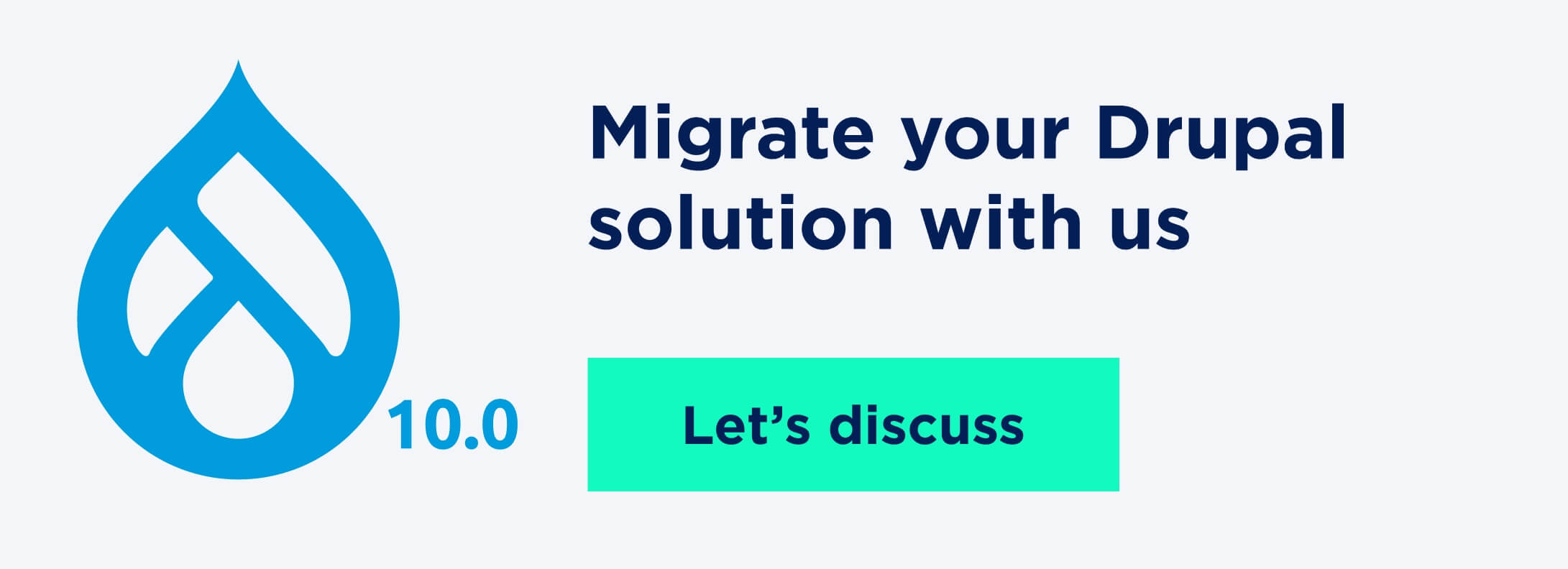For those who are worried about missing the opportunity to upgrade their websites, the Drupal 7 end-of-life date has shifted from November 1, 2023 to January 5, 2025. So, take a deep breath, and let’s find out how to handle the news and what to do next.
In our article, you will learn the upcoming changes, the risks of running Drupal 7 websites, the benefits of upgrading to Drupal 10, and how to make the transition smooth.
What is Drupal 7 end of life (EOL)?
Drupal 7 end of life (EOL) is a termination of support and updates for a Drupal 7 core. After the official EOL date, which is January 5, 2025, the Drupal community won’t provide any security updates and bug fixes and maintain some infrastructure for Drupal 7 websites. What does that mean for Drupal 7 users? Websites built with Drupal 7 are no longer secure enough to protect your data. Such websites won’t receive any updates to ensure their stable performance and smooth user experience. That is why the Drupal community recommends all Drupal 7 users to migrate their websites to the newest Drupal version.

What changes to expect?
To make sure that your transition to a recent Drupal version is smooth, take further Drupal community restrictions into consideration.
Before January 2025
You might have noticed modules and themes on drupal.org, which are marked as unsupported. Those will no longer be maintained and marked as supported again. Moreover, the Drupal community won’t provide any protection to the unsupported D7 modules and libraries (for instance, CKEditor 4). However, the Drupal community will still process non-critical D7 issues to minimize security risks, meaning that you can still check for updates.
Drupal core team has already ceased support of PHP 5.5 and is considering increasing the minimum PHP version requirement to cease supporting others in the future. To avoid any issues with these updates, ask a tech vendor with Drupal expertise to update your website to PHP 8. Moreover, Drupal won’t support third-party libraries for D7, including jQuery.
After January 2025
The Drupal community won’t support any operations towards Drupal 7 modules development after Drupal 7 support end date — January 5, 2025. Drupal 7 branches will be labeled as unsupported. The Drupal team will remove some Drupal.org infrastructure, which will stop the work of some Drush commands. Additionally, D7 website owners will receive notifications that the website is no longer secure. Some third-party scans may identify D7 websites as insecure.
The risks of running Drupal 7 after end of life

If you still plan to stick to Drupal 7 after its end of life, make sure you are familiar with the risks you may face in the future.
Security risks
Since your website will not receive any official updates after Drupal 7 end of support, your data will be vulnerable to malicious attacks. Critical issues with D7 may become public, which leads to an even higher possibility of website attacks.
Limited partnership formation
D7 websites will be marked as insecure, which means that other tech vendors will be less likely to cooperate with business owners whose websites are outdated. Running an insecure and outdated website can damage your organization's reputation. Users and potential partners won't be able to rely on your website, which leads to losing credibility and business opportunities.
Userbase losses
The Drupal community won’t create any new functionality for Drupal 7 websites, which means that business owners won’t have any access to new features and third-party services. Outdated websites will also become less compatible with modern web browsers and server environments. This can lead to issues with website functionality and performance, as well as losing your business value and end users.
Reduced search optimization
Google search engines prioritize secure and upgraded websites during search ranking. Running an outdated and potentially insecure website may lead to a decrease in your website's search engine ranking, reducing its visibility and traffic.
Staying with Drupal 7 is a risky decision since you expose your website to several risks, including security vulnerabilities, decreased functionality, no community support, potential reputational consequences, and user loss.
Benefits of upgrading from Drupal 7 to Drupal 10

To avoid the risks associated with Drupal 7 EOL, you should migrate your website to Drupal 10 (the latest version). Get ready to leverage new features that will strengthen your data security and attract more end users with Drupal 10! Here are the benefits of the D10 upgrade:
Enhanced security
Drupal 10 receives regular security updates, which will make your website a more reliable platform. With Drupal 10, you will protect your website for years, as it will continue to receive support and updates. Enhanced security will also attract more users and partners who will recognize your reliability and trust you with their projects and needs.
Improved UI/UX
Drupal 10 offers a much better editorial experience, which simplifies the work for website managers and content creators. They can quickly create visual layouts for content display with a built-in visual design tool. With Drupal 10, you can customize content arrangement or even create custom landing pages with an easy-to-use drag-and-drop interface. The default theme, Claro, has also brought a new life into the content creation process, making it easy and intuitive. As a result, your end users receive a positive experience with your website and smooth navigation through the content.
Increased performance
With Drupal 10, you receive a faster page load and more space for growth due to improved caching mechanisms and scalability. Due to the complete rework of the Drupal core, which is now based on the most recent version of the Symfony framework, it offers flexibility and performance improvements like never before. Moreover, Drupal 10 requires at least PHP 8.1 to run, which has proven to be significantly faster compared to previous versions.
Community support
Drupal 10 upgrade ensures that you receive active Drupal community support. You will constantly receive new design themes, open-source modules, and system integrations to maintain your website in good condition.
Even though migrating your website to Drupal 10 can be time-consuming, the website you’ll get after the upgrade will improve all your business processes. You’ll get enhanced security, improved UI/UX, increased performance, and community support.
How to ensure a smooth transition?
The complexity of website migration depends on your website’s scale and content structure. However, each migration is a delicate process and requires a knowledgeable Drupal team who can help you upgrade your website.
Our Drupal developers contribute to the Drupal community by creating patches and modules to improve the CMS. We have a proven track record of contribs, which you can check here. Our developers know Drupal inside out and always stay up to date with new features and tools.
Since Drupal 7 end of life extended, you have plenty of time to migrate your website without much risk and downtime. To make sure your transition is smooth, define your requirements and goals to communicate to a tech vendor. Your clarity about design, scale, and features will help the team meet your vision of the upgraded website.

Takeaway
Websites built on Drupal 7 will soon be completely left out of support. That is why the Drupal community recommends website owners to upgrade to the latest version — Drupal 10. Even though there is no direct upgrade path and the migration seems complex, professional Drupal developers can handle it for you. Such an upgrade will ensure improved security, website scalability, and access to new features. Drupal 7 end of life 2025 is your chance to grow and enhance your website’s functionality.
With the help of our Drupal developers, you can plan the migration carefully to minimize potential disruptions and integrate the features that will make your website attractive to end users. Contact us, and let’s discuss your migration project.



